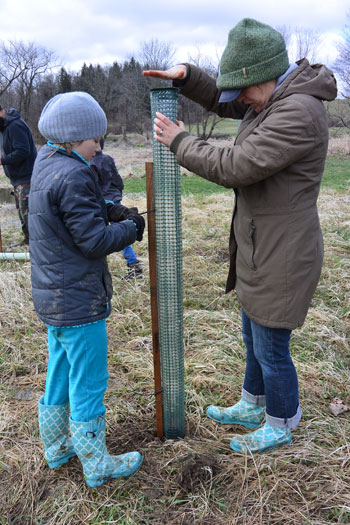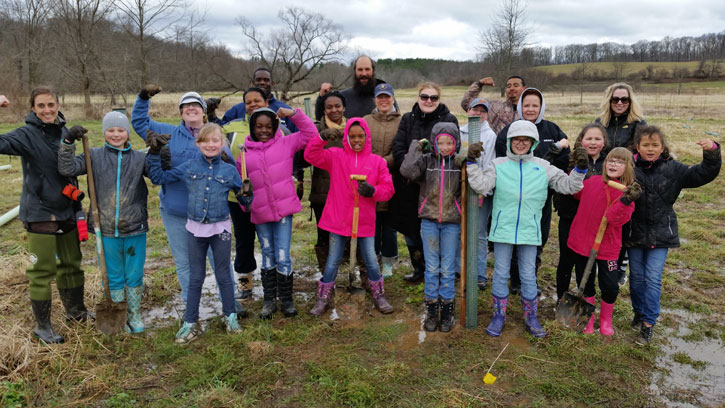By Tara Muenz and Matt Gisondi
This spring, more than 130 students helped Stroud Center educators and watershed restoration staff monitor streamside forests in the Middle-Schuylkill and Brandywine-Christina watersheds.
The in-field, service-learning opportunities were funded by a grant from the William Penn Foundation and designed to involve students in research to collect useful data on riparian-zone tree plantings, apply concepts and processes from their curriculum to the outdoor classroom, and learn about environmental stewardship.
Some groups collected data on properties where trees already had been planted; others planted and monitored new trees. Participants included students from Westtown School, Upland Country Day School, Pennytown Mennonite School, Junior Girl Scout Troop 457 from West Chester, and Millersville University.

Volunteers from Junior Troop 457 secure a tree shelter. Shelters protect the young trees from deer and rodents. Photo: Tara Muenz
Comparing the Effectiveness of Tree Shelters
Two student groups helped Distinguished Research Scientist Bern Sweeney, Ph.D., with a research project he designed to compare the effectiveness of two different kinds of tree shelters. Over a period of two days in April, 70 students from Junior Girl Scout Troop 457 and Westtown School gathered at Taylor Run to plant trees, install tree shelters, and collect data on 300 trees.
Located within the Stroud Preserve, Taylor Run is a tributary of the east branch of the Brandywine River that is in great need of restoration, as many of its banks are collapsing and severely eroding.
The data the students collected included tree species, planted tree height, and type of shelter. This same data was then checked for accuracy by comparing it to data previously collected by Stroud Center staff.
“Enthusiastic, Excited, and Engaged”
Sweeney said, “Throughout the planting and monitoring events, students were enthusiastic, excited, and engaged. Many had meaningful and thoughtful questions relating to the project, asking about the different shelter types, discussing what they thought the data would show, and asking about what more they could do to protect our waterways.”
Helping at the preserve helped us to earn our Bronze Service Award, which is the highest honor a Junior Girl Scout can achieve.” — Rolanda Hyman, Junior Girl Scout Troop Leader, Troop 457, West Chester, Pennsylvania
This area of the Stroud Preserve is in some way, a legacy forest for the students involved in this project. Our intentions are to continue working with the student groups to revisit the plantings, collecting data, and maintaining the tree shelters.
Moving forward, results from this spring’s experiences will help Stroud Center staff understand the role students can play in collecting meaningful reforestation data for scientists and land managers.

Assistant education director Tara Muenz (left) and volunteers from Brownie Troop 457 flex their tree planting muscles. Photo: Bern Sweeney



